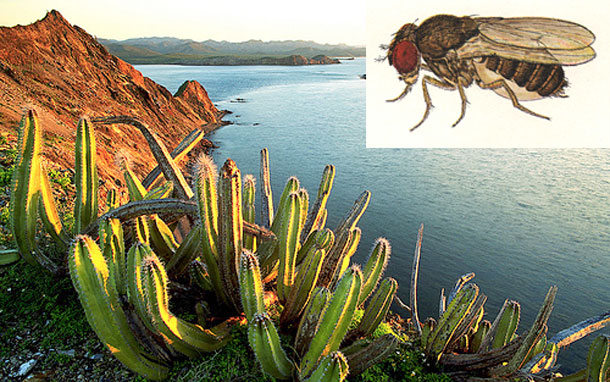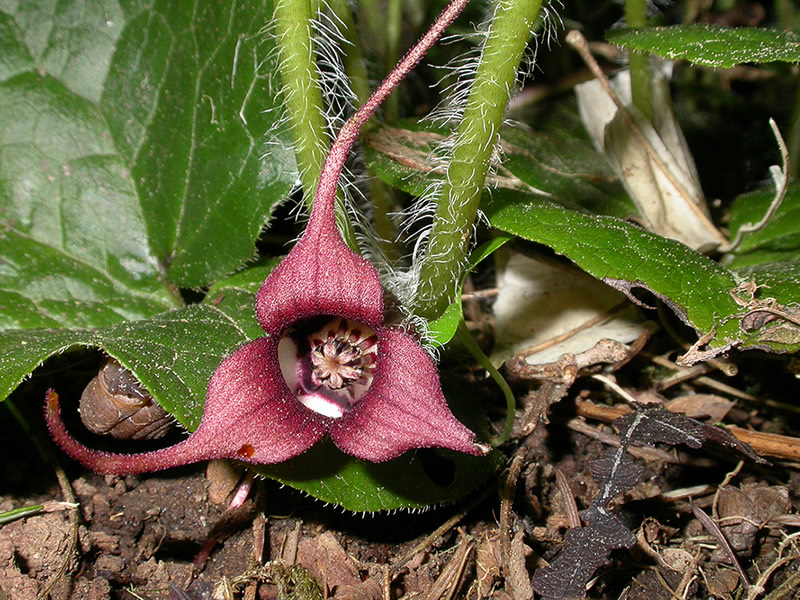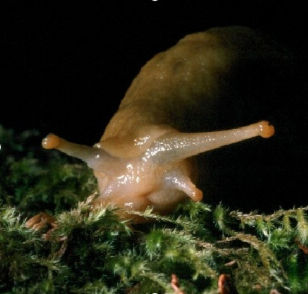|
Eric R. Pianka Enterobius Pinworms (Parasites on Primates) Brooks and Glen 1982 The term coevolution is also often used in a more restricted sense to refer primarily to the interdependent evolutionary interactions between plants and animals, especially their herbivores and pollinators. A plant may evolve a secondary chemical substance that deters the vast majority of predators, but if a particular herbivore can in turn evolve a physiological means of coping with the chemical deterrent, it can thereby obtain an uncontested food supply. Through this kind of coevolution, many herbivores have become strongly specialized on a single species or a few closely related species of plants. Thus, Drosophila pachea is the only species of fruit fly that can exploit the "senita" group of cacti; these plants produce an alkaloid that is fatal to the larvae of all other fruit flies, but D. pachea has evolved a means of detoxifying this chemical (Kircher et al. 1967).

Drosophila pachea and senita cactus. In many cases, such specialized herbivores even use a plant's toxic chemicals (often aromatic and quite pungent) as cues in locating and/or selecting their host plants. Some herbivores, such as the monarch butterfly, actually sequester plant poisons (cardiac glycosides in this case), which in turn make the herbivore itself unpalatable or even poisonous to its own potential predators.
Danaid butterflies and certain moths make double
use of polyuridine alkaloids -- these noxious chemicals are not only sequestered by larvae
and/or adults and used for antipredator purposes but are also exploited as chemical precursors
Attempts have been made to generalize about the coevolution of herbivores and plant antiherbivore tactics (Cates and Orians 1975). Feeny (1975) argues that rare or ephemeral plant species are hard for herbivores to find and hence are protected by escape in time and space; moreover, he asserts, such unapparent plant species should evolve a diversity of qualitatively different, chemically inexpensive defenses that should constitute effective evolutionary barriers to herbivory by nonadapted generalized herbivores that are most likely to find such "cryptic" plants. However, such qualitative defenses will be only minimal ecological barriers to adapted specialized herbivores, against which the plant's primary antiherbivore tactic is escape in time and space (i.e., not being found). In contrast, Feeny reasons that abundant and/or persistent plant species cannot prevent herbivores from finding them either in ecological or evolutionary time. Such "apparent" plant species appear to have evolved more expensive quantitative defenses (named that because they are more effective in higher doses). Examples include tough leaves of low nutrient or water content containing large amounts of relatively nonspecific chemicals such as tannins. Feeny points out that such plant defenses should pose a significant ecological barrier to herbivores, although perhaps only a weak evolutionary barrier unless supplemented with qualitative chemical defenses (some plants have both).  
Populations of wild ginger, Asarum caudatum, in western Washington are polymorphic for growth rate, seed production, and palatabililty to a native slug, Ariolimax columbianus (Cates 1975). Where slugs are uncommon, plants allocate more energy to growth and seed production and less to production of antiherbivore chemicals. In habitats with lots of slugs, less palatable plants have a fitness advantage -- even though they grow more slowly, they lose less photosynthetic tissue to slug herbivory. Correlates of Plant Apparency Apparent Plants Common or conspicuous Woody perennials Long leaf life span Slow growing, competitive species Late stages of succession, climax Bound to be found by herbivores (cannot escape in time and space) Produce more expensive quantitative (broad-based) antiherbivore defenses (tough leaves, thorns, tannins) Quantitative defenses constitute effective ecological barriers to herbivores, although perhaps only a weak evolutionary barrier unless supplemented with qualitative defenses Cates and Orians (1975) develop somewhat different but related predictions for early versus late successional plant species. Because early successional plants escape from herbivores in space and time, Cates and Orians reason that such plants should allocate fewer resources to chemical antiherbivore defenses than the more apparent plants of later stages in succession. Thus, early successional plant species should make better foods for generalized herbivores than later successional and climax plant species. Indeed, experimental studies on slug feeding indicate that early successional annuals were significantly more palatable than later successional species (Cates and Orians 1975). However, the opposite result was obtained by Otte (1975) in similar experiments with grasshoppers; these generalized herbivores accepted more later successional plant species than early ones. Otte suggests that this difference may arise from the difference in mobility between slugs and grasshoppers. In a survey of lepidopteran feeding habits, Futuyma (1976) found greater degrees of specialization to host plant species among insects feeding on herbaceous plants than among those that feed on leaves of shrubs and trees (this pattern neatly fits Feeny's plant apparency dichotomy). Futuyma suggests that plant defense systems are more diverse in floristically rich plant communities than they are in less diverse communities. Discrepancies among these studies indicate that generalizations concerning plant apparency are difficult to make and that they will have to allow for exceptions (for further discussion of this interesting area, see Rhoades and Cates 1976; Gilbert 1979; Futuyma and Slatkin 1983; Coley et al. 1985; and Chew and Courtney 1991). Plants and fungi have evolved a wide variety of chemicals to fight microbes such as bacteria that attack them. Antibiotics were first discovered in fungi, but have now also been found in many species of plants as well. Secondary chemicals of plants have proven to be a vast reservoir for useful pharmaceutical products. These include analgesics, diuretics, laxatives, tranquilizers, contraceptive pills, and cough drops. Clinically proven drugs derived from higher plants include morphine, codeine, atropine, quinine, digitalis, and many others. Bark of Pacific yew trees contains taxol, which has proven to be an effective agent in the treatment of certain ovarian cancers. To date, scientists have examined only about 1 percent of existing plant species for useful pharmacuticals. In some cases, plants have actually formed cooperative relationships with animals that result in their protection from certain herbivore species. By means of ant removal experiments, Janzen (1966) showed that some species of Acacia deprived of their normal epiphytic ant fauna are highly palatable to herbivorous insects, whereas species that do not normally have ants for protection from herbivores are less palatable. These acacias benefiting from ant protection produce Beltian bodies with a protein reward as well as nectaries and swollen thorns that attract and in turn benefit the ants! Thus, these plants put matter and energy into attracting ants that defend their leaves, rather than into more direct chemical warfare. This antiherbivore ploy is broad based, since the ants ferociously attack a wide range of herbivores. Ant protection may also reduce competition with other plants, as well as provide a measure of protection from fire, because the ants keep the ground surface clear immediately around their Acacia plant.
Many plants protect their seeds either by enclosing them in a toxic matrix
and/or by means of a hard shell. Some seeds are poisonous. Nevertheless the high nutrient content of seeds has resulted
in the evolution of effective seed predators. Predation on seeds may often be heaviest where they occur in greatest
concentrations (such as acorns underneath a parent oak) because seed predator populations will generally be largest
where the most food is available (Janzen 1971). As a result, the probability of an individual seed's surviving to
establish itself as a plant may often vary inversely with seed density. In many trees, most seeds fall to the ground
near the parent tree, with a continually decreasing number of seeds ending up at distances farther from the parent
tree. As a result of these opposing processes, Janzen suggests that recruitment is maximized at some distance from
the parent tree. Janzen's seedling ring model of seed predation and recruitment may help to
explain the high species diversity of tropical trees, which suffer heavy seed losses to specialized seed predators
that eat the seeds of particular tree species. (It neglects the question of why there are so many specialized seed
predators in the tropics.)
Intricacies of coevolutionary relationships between pine squirrels
(Tamiasciurus) and their coniferous food trees were studied in the Pacific Northwest by C. C. Smith (1968, 1970).
Conifer seeds constitute the staple food supply of these squirrels; they can effectively strip a tree of most of
its cones. Trees reduce the effectiveness of squirrel predation in many different ways: (1) by producing cones that
are difficult for the squirrels to reach, open, and/or carry; (2) by putting fewer seeds into each cone (squirrels
eat only the seeds themselves and must "husk" cones to get them); (3) by increasing the thickness of seed
coats, requiring that the squirrels spend more time and energy extracting each seed; (4) similarly, by putting less
energy into each seed (a drawback is that seedlings from smaller seeds have fewer resources at their disposal and
are presumably poorer competitors than seedlings from larger seeds); (5) by shedding seeds from cones early, before
the young squirrels of the year begin foraging; and (6) by periodic cone "failures" that decimate the
squirrel population, thereby reducing the intensity of predation during the next year. Thus, squirrel predation has
had profound evolutionary influences upon various reproductive characteristics of conifers, including details of
cone anatomy and location, the number of seeds per cone (and the variability in the number per cone), the time at
which the cones shed their seeds, the thickness of seed coats, and annual fluctuations in the size of cone crops.
Evolution of these defense mechanisms by the conifers has in turn forced squirrels to adapt in various ways, such
as choosing cones carefully and stockpiling them.
Fluctuations in cone crops from year to year are pronounced and are best
interpreted as an antisquirrel strategy, because they occur even when climatic conditions are apparently favorable
for trees. Apparently, the conifers withhold their products of primary production and store them for later use.
Cone crops and failures are often synchronized among different tree species in a given area -- a further indication
that the phenomenon is directed at the squirrels. Individual trees out of synchrony presumably set fewer seeds and
are thus selected against by natural selection. Smith points out that different conifer species have diverged from
one another in evolution of cone anatomy, size, location, and time of shedding but that these same conifer species
have converged in their fluctuations in cone crops. Both reduce the squirrel's efficiency. |